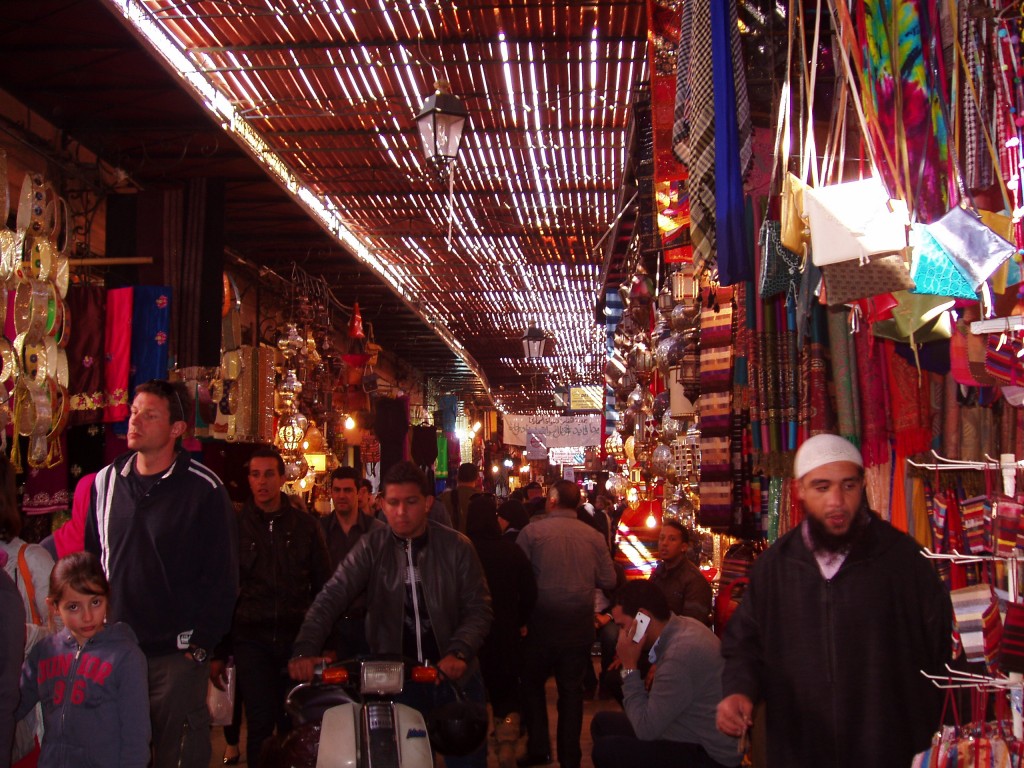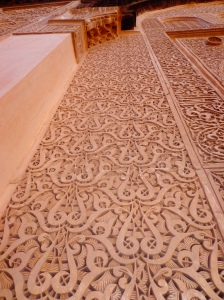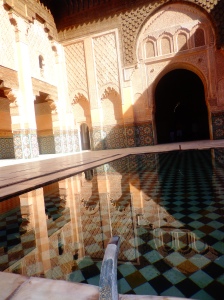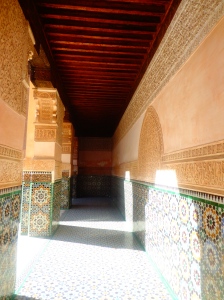So you want to travel to Morocco
This is our first in a series of “So you want to travel to…” posts. It’s surprising how hard-fought this knowledge was to acquire, so we figured we could put together a post that might make it a little easier for the next folks who might go. Questions are welcome in the comments!

Throughout our time in Morocco we made observations on things that struck us as quite different from our daily life experiences back home in the States or as different from other places we have traveled. Some of these observations are just culturally interesting but many will provide good tips for future travelers to Morocco.

Morocco is an incredibly diverse country with rural agricultural lands, busy medieval medinas (markets), deserts, mountains and beautiful lagoons along the Atlantic. We were fortunate to see all of this during our 3 weeks in the country.
When to Go
A lot of our early travel research was around weather (to do our best to avoid oppressive heat or monsoon storms). Morocco was plenty hot in late May, but we seldom hit a spot where we broke 90 degrees and the coastal towns (Essaouira and Oualidia) were 70-80F. For a Morocco-centric trip, we’d suggest May or October.
Where to Go
Morocco is a pretty hefty country but most of it is packed into the northern half with some desirable destinations on the coast. We researched destinations pretty thoroughly and settled on traveling to:
Fez for 5 days (photos)
Merzouga & the Sahara Desert for 3 days (photos)
Tinghir & the Todra Gorge for 2 days (photos)
Marrakech for 2 days (photos)
Essaouira for 7 days (photos)
Oualidia for 4 days (photos)
Of the destinations we hit, we felt like we had plenty of time but could’ve happily spent more time around the Todra Gorge (it was peaceful and beautiful), which would’ve given us time to explore the Dades Gorge as well (and Skoura, which is supposed to be pretty). If the weather and our digestion had been more cooperative, we would’ve trekked a bit in the Atlas mountains and perhaps sought out the barbary apes in Azrou.
Where to Stay (Dars and Riads, oh my!)
You’re doing yourself a huge disservice if you stay in a chain hotel in Morocco. Any destination you care to hit is generally full of renovated Dars (old houses built around a central courtyard) and Riads (old, larger houses built around central gardens). These are often cheap ($40-100/night) and downright glorious with beautiful tile and woodwork that can be hundreds of years old. The courtyards and gardens of these old buildings were an incredible contrast to the frenetic experience of a Moroccan medina… The were cool, shady, quiet, and often full of plants, fountains, and lounging furniture.
Booking these tends to be challenging compared to what we’re used to in the States– generally it involves 5-10 emails back and forth with the host and sometimes a paypal transaction. On the plus side, we never had trouble with vacancy– all of the highly rated dars we found had last-minute availability. Our general procedure for a new town was to go to TripAdvisor, hit the “Inns / B&B” tab, sort by price (lowest to highest) and then scroll down until we started seeing glowing reviews/rankings… Then we’d start looking at each individual place evaluating on how pretty it was, if the location was walking-friendly, if the beds were decent, etc. Checking AirBnB was a solid path as well– while a lot of the dars/riads weren’t represented there, it oftentimes made the transaction easier.
Transportation
Getting around without a car was easy– city-to-city busses are generally plentiful and cheap, with CTM being the best (they have air-conditioned busses and a reputation for being on time). Bus tickets between cities ranged from $8-20 per person and can be purchased at the CTM office in town any time before the trip (we never had a bus sold out). The CTM website is a UX disasater and in french– we never managed to buy a ticket on it, but did use it for scheduling a few times.
There are two types of taxis– “petite” (smaller, often with meters), which are great for cheap in-city transport (generally a buck or two) or “grand”, usually larger mercedes with negotiable fares. Grand Taxis are also used for city-to-city travel. There’s a grassroots system– the grand taxis hang out in a specific area and wait for a carful of passengers to accumulate for a specific destination, often cramming 6-7 people into the car. You can, of course, buy all of the seats if you’d like to leave sooner. Pricing here is brutal for tourists, so expect to haggle for any non-metered taxi ride. We largely avoided grand taxis because we didn’t enjoy haggling or being crammed into a grubby mercedes with a ton of other people.
And, of course, you’ve got walking. We quickly learned that an offline digital map is indispensable as the streets in most towns are damn confusing. Google Maps for Android has a “save to offline” feature, which we loved. Most people don’t know this, but the GPS in your smartphone works great even if you’re cellular service is turned off (DON’T use airplane mode)… Even if you don’t have an offline map, you can zoom in at a WIFI point and then start wandering, with the comforting blue dot reporting where you (roughly) are. That said, don’t expect addresses to work and don’t expect addresses found on sites like TripAdvisor to correspond to reality at all.
Language
English is pretty rare in Morocco. The local languages are Arabic (80-90%) and Berber (40-60%) while main foreign languages are French (33-39%) and Spanish (21%), with only 14% speaking English. This is certainly challenging at times, but we honestly found it refreshing as most every place we have traveled in the past (despite how exotic) it has been easy to find English speakers. We worked to learn a few Arabic phrases and even Berber, but then found that our Berber would only be good for one city as the next spoke another dialect. Our efforts were certainly rewarded with smiles and surprised looks by many when we spoke a few words in their native tongue.
Money and Credit Cards
Don’t expect to readily use your credit cards in Morocco. Cash (Dirham or Euros) were expected as payment in all of our accommodations unless we had paid online in advance. Moroccan Dirham was expected in most restaurants and stores. Coming from a world where we use our credit card for everything, this took some getting use to and some planning regarding regular visits to ATMs. And DO NOT assume that there is an ATM in every town. This bit us in the ass once when we had to take a cab back to the next biggest town to get money so that we could pay for our hotel and camel trek in the desert.
Shopping
Until we reached Oualidia at the end of our trip we did not see anything like a typical western store. We did tend to book our accommodations in the historic or medina areas of towns so this could be why. That said, our observation was that Moroccans living in the medina shop daily for fresh fish, meat and vegetables.
For other items there are hundreds of small shops specializing in just one or two types of items (e.g. bicycle tires, shoes, thread, lightbulbs). We somehow managed to find contact solution in the Fez Medina from a vendor who specialized in color contacts – that was a surprise!
Food & Drink
Vegetarians could probably do alright in Morocco, but diabetics may be in trouble. Breakfast was provided at all of the places we stayed and was consistently the same: fresh orange juice (often with sugar added), several types of local breads (some sugar coated), fruit, and jams, honey and syrups. A traditional English or American egg breakfast is not to be found, though we did have a Berber omelet once (eggs baked in sauce/veggies, tagine-style)! In addition, lots of sugar is added to the ubiquitous mint tea and even main course dishes.
The food (overall) was pretty universally tasty but it was hard to find a fabulous meal in Morocco. Common dishes include Tagines (meat and veggies baked in a tall clay pot), skewers of meat with spices, Pastilla (sweetened/spiced pigeon or other meat baked in phyllo dough topped with powdered sugar and cinnamon) and fish prepared simply near the coast. Street food was often just as tasty as sit-down food– our favorites were flatbread cooked with onions and smoked paprika and the chevre cheese vendors. You can get more exotic and grab a steamed sheeps head or some tehal (camel spleen stuffed with a sausage-pate sort of mixture, sliced and pan fried). Soups are also solid and filling, with Bessara (fava bean soup served with a big dollop of olive oil and bread) or Harira (tomato & chick pea) being on most menus. Our favorite meals were had in Essaouira. The stuffed sardines at Gnawa Blues were amazing. And the mixed salads at Restaurant Ramsess were the highlight of an exceptional meal that also featured local music. Fresh orange juice was available everywhere, usually for less than a buck for a big glass.
Across Morocco, it was rare to see Moroccan women in cafes, which were filled with Moroccan men along with occasional tourists. Female tourists particularly those traveling with a male companion seem to be perfectly accepted in local cafes and restaurants and Alex never felt uncomfortable. Drinking alcohol was also not something you ever saw any Moroccan, male or female, doing in public.
The People
Not once in our travel in Morocco did we get even a wisp of animosity or anger from a local. That said, Morrocans are certainly not the warmest people we’ve met in our travels (with a few awesome exceptions). Tony has a theory that the friendliness of a culture corrolates strongly to material prosperity. Not necessarily financial prosperity, mind you– but if food falls from the trees and springs from the earth, fresh water is plentiful, and shelter from the elements is either unnecessary or easy to come by, people have the luxury to be warm and welcoming. Morocco is a hard place with a tough history– it’s difficult for many of the locals to think of tourists as anything more than a fleeting natural resource to be harvested when given the opportunity.
We never once felt unsafe or threatened, but we’d warn future travelers to develop a hard edge when wandering thru the streets of large cities in Morocco. Merchants have all sorts of techniques to try to stop you to get you to look over their wares or menu. If someone makes eye contact and says “Hey, where are you from?”, it’s difficult to ignore the invitation to converse. If someone hands you a menu, it’s challenging to literally walk right through it… But you often have to do exactly that if you want to explore the Medina.
Nearly all Moroccans are Muslim and the other one percent are Christian or Jewish. This is certainly noticeable given the Islamic call to prayer over loudspeakers several times a day but we didn’t find it overwhelming. It was simply a clear part of daily life for many Moroccans.
Dressin’ for the Ladies
Alex chose to dress conservatively in both the rural places we visited and larger cities like Marrakech, wearing pants and always having her shoulders covered. Most guides recommend this for female travelers though you will certainly see some women ignoring this advice. While we did see some younger Moroccan women in the larger cities dressed more western, nearly every woman still wore a head scarf and of course many wore veils.
Favorite Web Resources for Morocco
As an internet guy, it pains Tony to give the nod to TripAdvisor (it is hard to support a site that still does pop-under ads) as one of the better resources for finding lodging and sights. With restaurants, TripAdvisor was less helpful but it often gave us a place to start- we never found a better alternative. They have offline city guides for the iPhone (basically just a bundle of their web content and a decent map implementation), but only for one town in Morocco.
I’ve been using the new Trippy a bit (it’s a pretty awesome community for travelers that I worked on a bit before we left) and it’s been quite helpful (right now it’s in closed beta and has a pretty small/exclusive community of travelers).
WikiTravel (the wikipedia of travel destinations) is useful for logistical stuff and sights but not remotely trustworthy for food.
Frommers and Rough Guides often have a solid list of restaurants and sights for any of the more frequented destinations– pretty much every town we hit, Tony would google “TownName Frommers” and “TownName Rough Guides” and poke around to see if there was anything useful.
Unesco was a favorite for Alex with great detailed information on world heritage sites in many of our destinations.
Google Maps is a godsend, even without a data plan. The GPS on your smartphone works everywhere, peeps.
Triposo is a great little app smartphone app. They have offline guides largely sourced from wikitravel, so the content is fairly weak. But they offer solid offline maps and have built in weather, currency converters, and language phrasebooks.
Should you go?
All in all, Morocco was a great opportunity to step outside of our comfort zone and see things that can’t be seen in the western world. It’s definitely off-the-beaten path, with even the larger destinations being poorly documented– maps are iffy, online ratings/reviews are often scarce, and logistics are challenging. When outside of the major destinations like Fez and Essaouira, we’d play “count the westerner”, and sometimes go half a day without breaking into double digits (almost none were American). Many times we were the only guests where we stayed. We hope others will add it to their destination list!

morocco culture,moroccan food,morocco food,moroccan cuisine,morocco beaches,moroccan meal,beaches in morocco,moroccan culture,hercules cave,hercules cave morocco












































 Crucial question: what’s the food like?
Crucial question: what’s the food like?




